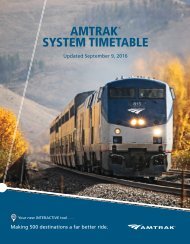Queens
northeast_queens_bus_study_-_final_9-28-15
northeast_queens_bus_study_-_final_9-28-15
You also want an ePaper? Increase the reach of your titles
YUMPU automatically turns print PDFs into web optimized ePapers that Google loves.
, Metropolitan Transportation Authority<br />
Q43 97% 92% 91% 96% 97% 97% 97% 88% 90% 90% 79% 100%<br />
Q44 92% 98% 91% 90% 94% 95% 100% 94% 95% 80% 86% 75%<br />
Q46 93% 88% 93% 98% 98% 96% 98% 77% 86% 85% 87% 86%<br />
Q48 71% 52% 72% 70% 79% 92% 67% 83% 44% 45% 33% 54%<br />
Q58 89% 94% 86% 76% 87% 89% 89% 99% 88% 95% 91% 88%<br />
Q76 60% 92% 97% 57% 60% 92% 97% 57% ‐‐ ‐‐ ‐‐ ‐‐<br />
Q88 100% 87% 92% 81% 100% 87% 92% 81% 69% 82% 89% 97%<br />
X68 97% ‐‐ 87% ‐‐ ‐‐ ‐‐ ‐‐ ‐‐ ‐‐ ‐‐ ‐‐ ‐‐<br />
*Q20 Saturday and Sunday service is scheduled with the Q44. Q31 weekend service<br />
Schedule Guidelines<br />
Schedule guidelines establish the minimum service frequencies for bus and subway service. This is<br />
intended to maintain basic mobility coverage throughout MTA’s service area. The minimum frequencies<br />
for bus and subway service vary by time of day and by day of week. In many cases, however, routes need<br />
to operate at shorter intervals than the guideline minimums in order to accommodate higher ridership<br />
levels. In these cases, loading guidelines match service to the number of riders using a particular route at<br />
a given time.<br />
Minimum Service Frequencies<br />
Local Bus<br />
All Times except Late Nights: If service is provided, it should operate at least every 30 minutes.<br />
Late Nights (1 a.m. – 5 a.m.): If service is provided, it should operate at least every 60 minutes.<br />
Express Bus<br />
Weekday Peak Periods and Weekday Middays: If service is provided, it should operate at least<br />
every 30 minutes.<br />
Weekday Evenings and Weekends: If service is provided, it should operate at least every 60<br />
minutes.<br />
Bus Stop Furniture<br />
Several furnishings enhance the comfort and environment at bus stops, including shelters, seating, and<br />
customer information in Guide‐a‐Ride canisters. MTA bus stops in the city are delineated by two types of<br />
signage. All NYCT bus stops have lollipop signs displaying the bus route numbers, bus destinations, and<br />
stop location. MTA Bus Company bus stops that are shared with NYCT have lollipop poles as well, but<br />
some bus stops served exclusively by MTA Bus Company routes have simple metal pan signs only<br />
displaying route numbers.<br />
Bus Shelters<br />
In Northeast <strong>Queens</strong>, 27.6% of bus stops have bus shelters, compared to 25.2% in all of <strong>Queens</strong> and 27.2%<br />
citywide. The Q50 and Q34 have the highest percentage of bus shelters per stop, with 44.6% and 44.3%<br />
of the respective stops enhanced with bus shelters. The route with the smallest percentage of shelters at<br />
bus stops is the Q19, for which less than 12% of bus stops have shelters.<br />
Bus Stop furniture is under the jurisdiction of NCYDOT, not the MTA. While the MTA supports the<br />
installation of bus shelters and benches as a way to improve customer comfort, community requests for<br />
additional locations should be transmitted to NYCDOT for consideration.<br />
53



